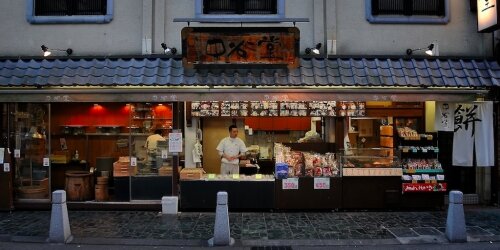This is how you prepare rice cakes in Nara. You take the rice and beat it until it gets green! 
Japanese rice cake made from glutinous rice is called mochi (餅). It requires quite laborious process to produce a smooth mass. Most cakes sold nowadays are machine-made, but beating the rice is still a popular outdoor event in Japan in winter.
A special kind of rice is first boiled then put into a wooden mortar and pounded with wooden mallets.
Nakatanido (中谷堂)—a shop in Nara—offers not only fresh pastry, but also a performance when preparing it. The rice mass is pounded manually (at least in the last stage) in a high-speed show that the shop owners became famous for.
How Japanese rice cakes taste?
The rice cake itself is not sweet, however filled with anko sweet bean paste it becomes a confectionery called daifuku mochi (大福餅). You can read more about it in a Wikipedia article.
The green color comes from yomogi grass. The rice mass is put into a machine that forms the cakes and injects sweet bean paste. Then the cakes are wrapped in kinako soybean flour.
You can visit the shop online at Nakatani-do (unfortunately all in Japanese), but it’s better to come in person and taste their yomogi mochi. One piece costs 130 yen and you can buy it almost immediately as it was prepared.
This post is my first contribution to:





